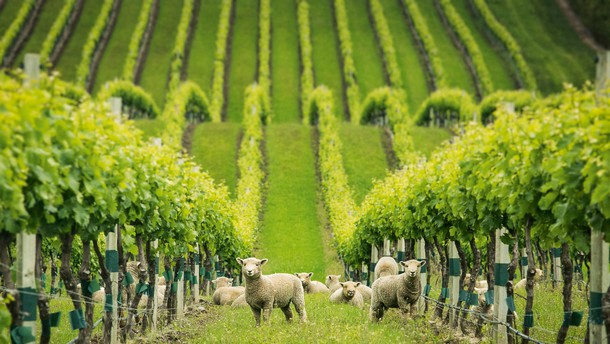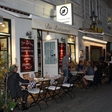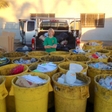

What do you say about "green" mass production? Peter Yealands, a silver-haired gentleman, proves it's possible, literally and figuratively. Think of romantically undulating green knolls, perfectly planted green vines, green production of marvelous and prize-winning Sauvignon Blanc or grazing babydoll sheep in the north-eastern part of the New Zealand's South Island.
I care about nature, I really do. I believe in it, just as I believe that, in the 21st century, caring for the environment should be our number one priority. But what if I tell you that I love motorbikes and traveling, that this article wouldn't have been written without considerable consumption of fossil fuels on the way? Rather contradictory, isn't it?

Nature aside, I also care about a good bottle of home-made wine. It goes without saying that small wine cellars offer more of a pleasurable experience, compared to high-end shopping malls, when it comes to buying wine. "Hello my friend, I haven't seen you around lately, how have you been?" This might be the start of a conversation in front of a cellar, one that might culminate inside with a wine tasting and a cold-cut platter of salami and cheese, which always seems to materialize out of the blue. No wonder I've often had to extend my "quest for wine" until the next morning, surrounded by interesting people who cannot hide their love for grapes. But why should I toast over dinner with wine that has been, in the eye of the global wine industry, produced on a mere 1500 hectares of land?

Well, while traveling from Christchurch to Auckland, I happened to follow a sign that read "Seaview," which I stumbled upon somewhere along the north-eastern part of southern New Zealand, thinking it was pointing me to yet another well-marked tourist sight. "Wow, these vineyards are wonderful," I thought to myself, and it wasn't until a few kilometers down the road that I grasped the vastness of this place. If this were a classical mass-production fruit factory (think of the hideous Spanish plantations decked in polyvinyl), I would have turned around in an instance.
The land of this Pacific coast, back in 2001 when Mister Yealands first invested in it, was merciless and abounded with sheep. "It was difficult to survive by relying on sheep breeding alone, and as a result farmers often resorted to selling their land," explains Mr. Yealands, who dropped out of school with the permission of the principal and his parents, at the age of fourteen, only to commence working at his father's store. As told in a book titled A Bloke for All Reasons--the Peter Yealands Story, by his friend and business partner, Peter Radich, his lack of formal education allowed him to tackle seemingly unusual and impossible projects without being tied to an idea that something wasn't executable. His wine production undertaking was no exception--consumption aside, he was a novice to the business. He sat behind a digger and transformed the land into romantic knolls that he neatly planted with vines, using a local tridimensional GPS system. Beautiful aesthetic aside (just look at the photos), this project is a practical success: the vast majority, 95% of the crops, can be harvested by tractors alone, be it sunny, rainy or even at night.

"Does manual harvest yield better results than automated?" I blurt out a question that, at the time, seemed somewhat awkward. "That's a common conviction, though I doubt that a harvesting method alone can make a big difference. You've tried it, haven't you?"
True, the same day that I came across the Yealands Estate Winery, I learned about winemaking and I found Slovenia mislabeled on the world map, which was used by the visitors to mark their country of origin. I found that, of all the wines I tasted, the wonderfully fruity Pinot Gris was my favorite. Their crown jewel, however, is Sauvignon Blanc, which accounts for 70% of their output. Once you set foot on the estate, you may want to buy a bottle, order a snack, explore the estate at your will, or even organize a private picnic. As you indulge in the fruits of the land, with the view over the churning waves crashing into a cliff, you may notice small, woolen fuzz balls–the English Baby Doll sheep. "We have them to avoid trimming the grass with such frequency. If you added up the distance between all of our vines, you would match the length of both New Zealand islands. And they're small because sheep of average size would reach the grapes and eat them," Peter tells us. But sheep are not the winery's sole contribution to the environment. While he once put his business before the environment, felling trees and selling the wood to Asia, he is now determined to make it up to nature. "In the past, I did things I'd never consider doing today. You could say that I was passionate about trees once, but unfortunately only about cutting them down," he said at the New Zealand business conference in 2008. His estate thus features over 27,000 native trees, some of which were planted by his entire staff on my second day at the estate, when he spared a few minutes for this interview. When was the last time your boss has taken you out to plant a few trees?

The estate boasts many wind turbines and solar panels--for information on air temperature, wind speed, solar strength, precipitation and a live picture from different stations across the estate, you can go to yealandslive.co.nz. Let's continue where we left off: the roof of the largest building on the estate collects water that is heated as needed with 200 kg bales of clippings from pruned vines. Energy-wise, one bale equals 60 kg of LPG gas. Their fertilizer comprises algae and fish waste from local fishermen. They're in the process of testing a fuel cell tractor, which can be seen on the estate, while their official vehicles are largely hybrids. To reduce the number of business-related trips, especially transoceanic flights, they rely on modern information technologies. Why fly over the Pacific, when you can organize a meeting by videoconference?

Recycling bins are a presence throughout the estate, and to reduce the consumption of electrical energy due to lighting, they use movement sensors. As spraying is necessary, they utilize organic materials whenever possible, though owing to the Pacific wind, the conditions for disease development are less than normal. To mitigate the recycling process and transoceanic transport in terms of weight, the Yealands winery sells their wine in plastic bottles, under the brand name Full Circle.

Do you want more? Over the course of eight years, the number of their employees has tipped over 140. In the face of personal issues or other concerns, the staff receives nothing but words of encouragement, their work is well-appreciated and rewarded, and to top it all off, they can also participate in a marathon that takes place in, and is organized by, the vineyard. If you happen to have ideas on how to make wine production even greener, you are welcome to submit them via a form, "Green Idea Submission," through their website. "The form has generated many great ideas, some of which we're already implemented in our winery," Peter tells us.

"But how green can it be, to ship your products all over the world?" I have to ask, wanting to know how a bottle of wine travels from the other side of world all the way to my cellar. "All of our wine, without exception, arrives at its destination with zero carbon footprint. Also, choosing boats is a much more efficient way to ship goods than going via road freight transport. Recent studies have shown that wine transport from New Zealand to England yields less carbon footprint than from the Laungedoc-Rousillon region in the south of France," Peter firmly states. He also believes that the vines love classical music. What? Yes, that's correct: in some areas of the estate, you'll find pillars with solar panels and speakers that play classical music, powered by solar energy. "It has been proven that classical music affects plants in laboratory conditions; playing classical music has also been widely practiced in the New Zealand milk industry, because it increases milk production. When played to our hens, their eggs were bigger by 18% on average," the silver-haired man explains vividly. "Does it promote vine health? Who knows, but it most certainly doesn't do any harm. The visitors love the music, which has become part of the experience."

The Yealands Estate has set out to become a leading wine producer from New Zealand, selling all over the world. As demonstrated by "The World's Best Sauvignon Blanc" award from the International Wine Challenge competition, and "The New Zealand's Best Wine Producer" award from the International Wine & Spirit competition, their work has paid off. The Yealands team, however, is most proud of the "World's Most Sustainable Medium Sized Entity" award, which they received at the International Green Awards. Every year, the Yealands Winery welcomes about 18,000 wine aficionados, students and entrepreneurs, all eager to explore the different ways wine can be made. And at 67 years of age, Peter Yealands doesn't seem to be showing any signs of retiring. Recently he sold a majority sharehold in his company to Marlborough Lines, owned by the local community. The reason? To expand the estate. Fifteen hundred hectares weren't enough. "Think boldly, tread lightly and never say it can't be done," is his long-time motto. Here's to many more years, Peter.



